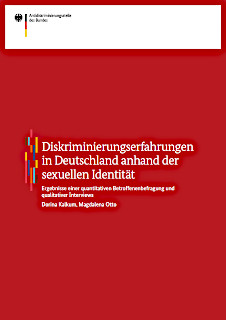Discrimination experienced on the grounds of sexual identity in Germany
Results of a quantitative survey and qualitative interviews of affected individuals
- Fact sheet on the research project -
Authors: Dorina Kalkum and Magdalena Otto, Berliner Institut für empirische Integrations- und Migrationsforschung, published by the Federal Anti-Discrimination Agency (FADA) Year of publication: 2017
Brief overview
This study provides a comprehensive overview of the discrimination experienced by lesbian, gay, bi-, pan-, demi- and asexual individuals across various settings. It explored not only the discrimination itself, but also the resources and strategies that those surveyed can access to defend themselves as well as the support services and changes needed. The 'survivor' survey 'Discrimination Experiences in Germany' evaluated 2,500 instances of discrimination based on sexual identity. This evaluation was complemented by qualitative group and individual interviews as well as expert discussions.
Main results
Discrimination experienced based on sexual identity
- The majority of the cases of discrimination occurred in public and in recreational settings (32.5 per cent).
- The second most frequently cited setting was the workplace, followed by public services and authorities at 14.9 per cent as well as the internet and media at 13.5 per cent. The area of education, goods and service sectors as well as the health care sector and long-term care settings each accounted for less than 10 per cent of cases.
- The discrimination experienced manifests most commonly as derogatory remarks and portrayal (53.3 per cent), slurs and insults (39.4 per cent) or the denial of rights (39.4 per cent).
- 46.7 per cent of the respondents found it stressful to have intrusive thoughts about the discrimination experienced. 45.3 per cent have become more sensitised to discrimination and 39.6 per cent reported having become more distrustful.
- Interviewees frequently reported that their sexual identity was seen as non-conformist, requiring them to do a lot of explaining.
Workplace experience of discrimination on the basis of sexual identity
- Discrimination in the workplace includes, inter alia, negatively biased performance assessments (64.1 per cent), not being hired (31.1 per cent) and being passed over for promotions and pay rises (22.8 per cent).
- In most cases, superiors or supervisors were the offenders behind workplace discrimination (57.5 per cent).
- In 47.7 per cent of the cases, colleagues were complicit or (co)offenders.
- In none of the situations described did those affected obtain help from their superiors (0.0 per cent).
Physical assaults and (sexualised) harassment motivated by sexual identity
- Overall, 33.5 per cent of the accounts related to sexualised harassment. While sexualised comments were part of almost every account (99.1 per cent) of sexualised harassment, sexualised assaults were reported at a clearly lower rate (5.7 per cent).
- Frequently, intimate questions are asked, and especially lesbian, gay, bi- and pansexual persons are commonly confronted with (sexually) suggestive language.
- Discrimination in the form of physical assaults or threats accounts for 10.7 per cent of the discrimination experiences due to sexual identity.
- Specifically, physical assaults and threats based on sexual identity mainly occur in public and recreational settings (68.5 per cent), making it twice as common as physical assaults and threats on the grounds of any other characteristics set out in the General Equal Treatment Act (AGG).
- In 68.1 per cent of the cases, interviewees reported that the offenders were persons they did not know.
- The group most affected by physical assaults and threats based on sexual identity are trans* and inter* persons, at 10.5 and 15.4 per cent, respectively.
Strategies those interviewed resort to when faced with discrimination
- Approximately 45 per cent of those polled said they reacted to the discrimination. This included verbal responses, leaving the situation, stressing the normality of their own sexual identity or concealing it, going humorous or ignoring it.
- In an effort to stand up to discrimination, those affected resort to various resources such as counselling centres and similar services, draw on their own competences and activism and count on the support from their social environment (chosen) family, friends, peer groups and communities.
Options for action
- Providing age-appropriate information about different sexual identities as early as in kindergarten, making topics such as sexual identities and family forms a fixture of curricula, representing them in educational resources and the media.
- Especially staff in human resources management should be sensitised to discrimination. Specifically, they should be pointed towards options for intervention and prevention.
- Sensitising the staff of public services and public authorities, the health care and long-term care sectors and those working with refugees.
- Greater networking among the different associations and initiatives to ensure that also persons with restricted mobility have more opportunities for contact and social interaction.
- Increase funding for counselling centres and education projects with a multidimensional approach and those that look at topics that have not been given proper attention so far, such as those concerning lesbian, bisexual or trans* and inter* persons.

